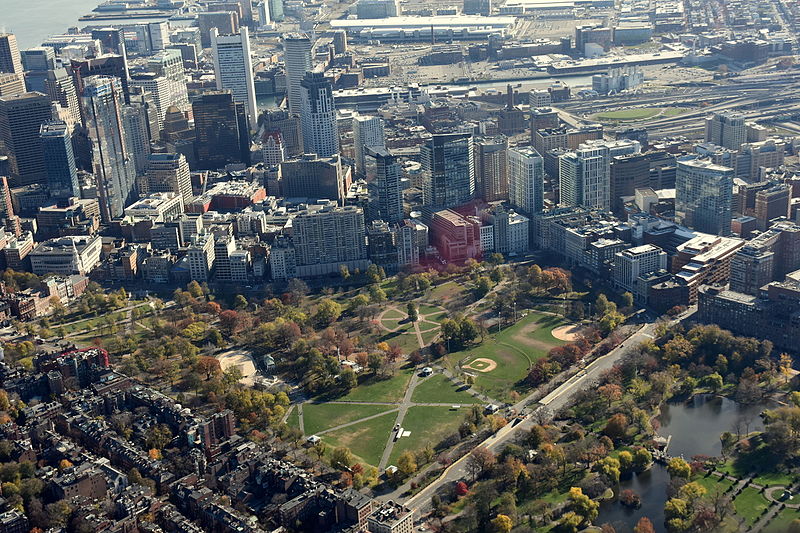The "commons" is the land and resources (forests, fisheries, water sources, and open spaces) that are owned by all members of a society. It is an old old concept, dating back to the Roman Empire.
Unlike private property, commons are public spaces to be used and enjoyed collectively. Everyone (including state and local governments) is expected to maintain and improve shared commons for current and future use.
But just about every community in the United States has some sort of common area, such as a town common, a parkland, a walking path, a wilderness area, an athletic field or court, a splash pad, a skate park, a playground, a historic battlefield, picnic areas, or a reflection bench beside a river or at the top of a hill or mountain.
 Boston Common aerial by Nick Allen is under CC BY-SA 4.0
Boston Common aerial by Nick Allen is under CC BY-SA 4.0
Fundamental tensions exist between common spaces and private property (e.g., land or resources owned by a private individual or organization). Private resources are not open to everyone and exist for the use and benefit of the private owner. John Malone, a telecommunications entrepreneur, is the largest landowner in the United States with 2.2 million acres in 5 states - land that is more than half of size of Lake Ontario, one-third the size of Vermont, and twice as large as Rhode Island (These People Own the Most Land in America, February 23, 2021).
The idea of private property emerged in England in the 17th and 18th centuries. Prior to this time, land was there for everyone’s use (think of Robin Hood and his band living off the land in Sherwood Forest). Rising populations and the need for food, along with the coming of the Industrial Revolution, led to the enclosure of agricultural lands. Through enclosure, private owners could wall off or fence off land from public use (Wall, 2017).
Local, state, and the federal government are responsible for maintaining public common spaces. They get the funds to do so from people’s taxes, user fees (money paid to access a facility), public-private partnerships, and donations from supportive individuals and groups. In times of ever-rising costs and tight budgets, there is never enough money to fully cover the expenses of common spaces. Governments face tough choices about whether to sell public lands to private developers to cover other expenses. For example, the Trump Administration sold low-cost leases to private companies for oil and gas drilling on public lands, a move it defended as good for the economy.
In the following activities, you will explore local and state commons and identify ways to use media to increase interest and civic engagement in protecting a commons of your choosing.
Activity 1: Design a Social Media Video to Increase Interest in Common Spaces in Your Community
- Identify a commons in your local or state community.
- Research this commons - what type of facilities and resources does it provide? Is it free? How does it make money?
- Visit the commons and capture video, audio, and photos.
- Design a social media video (e.g., TikTok, Snapchat, Instagram) to encourage members of your community to visit the commons.
Activity 2: Suggest Ways to Use Media to Encourage Citizens to Protect Local and State Commons
- To get started, look at the Town Common webpages for the following Massachusetts communities: Hadley, South Hadley, Greenfield, Easthampton, and Montague/Turners Falls.
- Consider the following prompts:
- What information is shared? What information is missing?
- What visuals are provided, if any?
- How inviting and accessible is this site?
- Now choose a local or state commons and examine how the local or state government shares information about that commons on social media and on websites.
- Based on your findings, craft a multimodal proposal (featuring images, video, and/or audio) to encourage your local or state government to improve their use of media to inspire citizens to protect the commons.
Additional Resources
Connecting to the Standards
- Massachusetts Civics & Government Standards
- Give examples of tax-supported facilities and services provided by the Massachusetts state government and by local governments. (Massachusetts Curriculum Framework for History and Social Studies) [8.T6.9]
- ISTE Standards
- Knowledge Constructor
- 3a: Students plan and employ effective research strategies to locate information and other resources for their intellectual or creative pursuits.
- 3b: Students evaluate the accuracy, perspective, credibility and relevance of information, media, data or other resources.
- 3d: Students build knowledge by actively exploring real-world issues and problems, developing ideas and theories and pursuing answers and solutions.
- Creative Communicator
- 6a: Students choose the appropriate platforms and tools for meeting the desired objectives of their creation or communication.
- 6b: Students create original works or responsibly repurpose or remix digital resources into new creations.
- 6d: Students publish or present content that customizes the message and medium for their intended audiences.
- DLCS Standards
- Digital Tools (DTC.a)
- Collaboration and Communication (DTC.b)
- Research (DTC.c)
- English Language Arts > History/Social Studies Common Core Standards
- CCSS.ELA-LITERACY.RH.6-8.5
- CCSS.ELA-LITERACY.RH.6-8.7
- CCSS.ELA-LITERACY.RH.9-10.7
- CCSS.ELA-LITERACY.RH.11-12.7